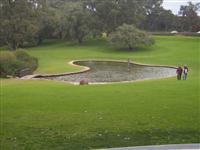Lawn Repair | Distance Education Turf
 Got a really sad lawn? Between drought, winter and the routine problems of too much wear and tear; many of us have lawns that are short on grass and either full of weeds or bare hard patches of soil. Here’s what to do.
Got a really sad lawn? Between drought, winter and the routine problems of too much wear and tear; many of us have lawns that are short on grass and either full of weeds or bare hard patches of soil. Here’s what to do.
What do you do to renovate a lawn?
The three most important steps in renovating a lawn are:
- Reducing or eliminating weeds.
- Aerating the soil to improve water and air penetration.
- Establishing lawn grasses in the bare spots.
Removing weeds
Most types of grass grow slowly in winter, giving weeds the opportunity to grow strongly. If you only have a few weeds, dig them out with a hand weeder (eg.a two-pronged weeding fork). For more severe weed problems, spot spray with glyphosate (ie. Roundup) or, if the grass is growing actively, use a special lawn weed/feed spray that won’t harm the lawn grasses.
Replant with seed or turf as soon as the weeds die off; otherwise they’ll simply take over again.
If thatch is a problem, remove it by raking before you spray the weeds (see below for instructions); planting new grass over the top will simply perpetuate the problem.
What is thatch?
A layer of dead and living stems that builds up between the green vegetation and the soil surface. A thick layer of thatch will feel spongy underfoot and prevent water, air and fertiliser penetrating the soil.
Kikuyu, Buffalo and Queensland Blue grasses are especially prone to thatching.
Aerating the soil
Many lawn problems are caused by soil compaction, as people and vehicles repeatedly move over the lawn. Wet soils are especially prone to compaction.
For small lawns, use a garden fork to aerate the soil. Work the fork backwards and forwards at approx. 10 cm intervals to open up the soil.
On larger lawns, a coring machine will do the job quickly and thoroughly. The coring machine removes small plugs of soil, leaving them on the surface of the soil. These machines can be readily hired from some tool hire companies. If you can’t find one ask for suggestions from your local golf course or bowling club staff.
The holes can then be filled with topdressing soil or coarse sand which will improve the drainage and aeration properties of the soil.
In severely compacted or contaminated soils, it may be necessary to lift the turf and replace or cultivate the sub soil, before replanting.
Re-establishing lawn grasses
In cold winter climates these methods should be employed in spring.
- Spot treatments; once you’ve got rid of weeds and thatch, rake the soil level (top up the soil first if necessary) and scratch the surface to allow seeds to get into the cracks. Then spread seed over the bare patches. Cover the seed with a thin layer of topsoil or top-dressing to prevent it from being eaten by birds or rodents, or being washed or blown away.
- Returfing: You can either plant runners (ie, pieces of stem from creeping grasses) or lay rolls or pieces of turf (sod).
It is important to choose the right type of grass. Some are hardier than others and more suited to one climate or soil than another. Very few grasses do well in shade; so don’t expect too much from a shaded lawn unless you do some sound investigation and maybe even experiment with a few different varieties before settling on a particular type of grass for the location.
If water has been a problem during the drought; make sure you use a drought hardy variety. All grass needs water; but some can survive drought much better than others; particularly if you avoid too much wear & tear.
Other Lawn Renovation Treatments
De-thatching
If thatch has built up too much, cut the lawn closely and rake it with a steel rake. You may need to mow and scarify it several times, until there is a bare cover of grass. Some cylinder mowers have combs mounted behind the front rollers to aid de-thatching. Regular vertical mowing or light scarification will reduce the need for de-thatching.
Note: this is best done when the grass is growing and will recover quickly (not in extremely hot or cold weather).
Liming the Soil
Poor lawn growth can sometimes be a result of acid soils. Some soils are naturally acid. Others become acid through the repeated use of lawn fertilisers that contain sulphate of ammonia, or even manures. A dressing of lime or dolomite during winter will help to reduce acidity, and can sometimes work a miracle on struggling grass. Apply at the recommended rate though, as too much lime encourages clover and other weeds to flourish. Lime should be well watered in to prevent scorching of grass. Rain will wash the remaining residues into the soil and so prepare the turf for the coming seasons growth.
Liming may be needed more often on very sandy soils than clays.
You may also be interested in....